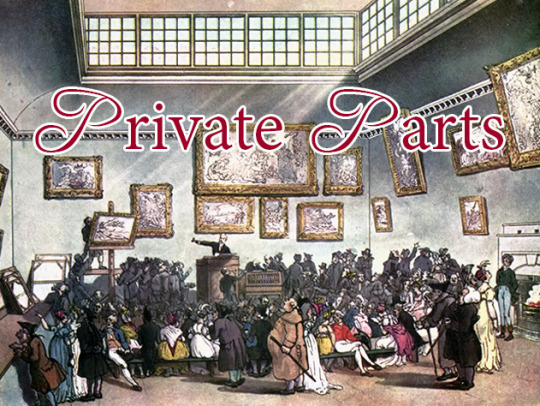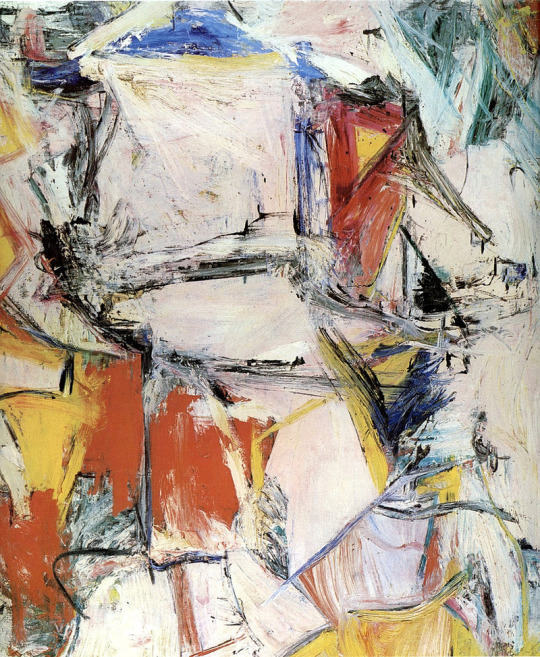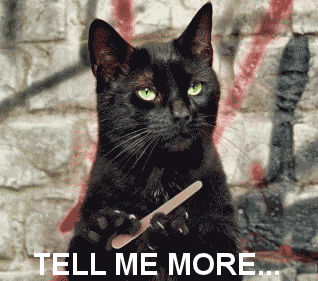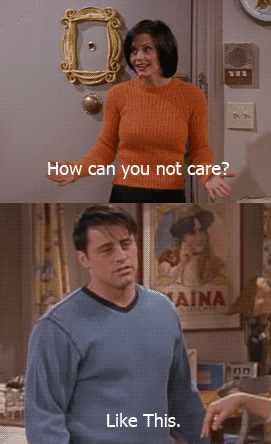
Private Parts is a series exposing the raw, gritty, and true stories behind artworks in private collections. Every week, you’ll find the untold tales of the back stabbings, thefts, and $100 million deals that move these works to secret lairs and impregnable vaults around the world. We’ll always be crazy in love with museums and galleries, but we also believe in giving the people what they want: All the art.
This week, behold Willem de Kooning’s Interchange.

SOURCEYeah, that’s the good stuff right there.
Just this last month, de Kooning’s deconstructed romp through one of the more atavistic corners of the human psyche was propped up on a plinth of propriety. Having either dethroned or been put in a dead heat with Paul Gauguin’s Nafea Faa Ipoipo as the world’s most expensive painting at a purported selling price of $300 million (more on that later).
It’s all quite a drastic upturn for the artwork, you see, since the painting was largely associated with one of the biggest bonehead moves in the history of art auctioning for the better part of the last thirty years. It all started when a guy going by the name Mountain Tortoise clinched the deal for Interchange at an auction in 1989.

Sotheby’s was hawking off the estate of Edgar J. Kaufmann, Jr. Heir to a department store fortune in Pennsylvania. Interchange was one of those lots, having been in Kaufmann’s collection since he bought it for $4000 the year it was painted, which keeping inflation in your thoughts and prayers, would make the initial purchase in excess of $35,000 in today’s human money.
The auction was going as planned, for the most part. Sotheby’s had estimated everyone would clear a couple million off Interchange. Maybe even $7 million, which sounds like a great time for everyone involved. Then some wiseacre ups the bet by more than $6 million in one go. Bidding turns into a free-for-all.
People get desperate, wanting the thing because everyone else seems to want it. The dust settles and an uneasy calm moves across the auction house. Senses returned and one person was left with their paddle in the air. At $20.86 million, one anonymous bidder going by Mountain Tortoise had cleaned up, bringing home Interchange once-and-for-all.

Only Mountain Tortoise wasn’t the guy’s real name. Shigeki Kameyama was a Japanese businessman turned art dealer whose gallery was called Mountain Tortoise. He was back in the Sotheby’s auction house the following night for a primo Picasso painting of his famed mistress Marie-Thérèse Walter. All said and done, the two paintings set him back almost $50 million.
The sale accounted for a couple big firsts in the art world. It was the highest recorded sale price at the time for both a work of contemporary art and an artwork by a living artist. But it also accounted for a huge ‘never again’ for everyone involved. The sale shut out Shigeki Kameyama from ever again being taken seriously in the art world. He didn’t have the cash for the bids.
Shigeki was calling around New York within days of the auction trying to pawn off his little boners. Telling people that he’d done it all for an investor in Japan that backed out. Claiming, variously, that the investor decided the prices were too steep or that the person simply changed their mind.

In any case, Kameyama, even with a fortune from real estate in southern Japan, couldn’t make good on the investment. Sotheby’s took the hit, paying off the paintings’ former owners. That is… they cleaned up Mountain Tortoise’s mistake if he agreed to sell off about thirty paintings. The sale happened anonymously, likely to save face for the terrestrial testudine, but didn’t even result in the sale of every painting.
The record’s thin on Interchange’s transfer from Kameyama to music and movie mogul David Geffen. Whether it happened directly or through some temporary intermediary, Kameyama lost a ton on the deal. By the turnover to the new millennium, Geffen owned Interchange counting the painting as a cornerstone in his $2 billion art collection.
Cornerstone it stayed for years, until last fall by way of last month. In mid-February, industry insider Josh Baer reported that a $500 million art deal had transferred stewardship of just two paintings from the best coast to the Midwest. Before leap year, the art world gushed the deets.

The deal was between David Geffen’s foundation and Ken Griffin, hedge fund extraordinaire and Chicago’s wealthiest human, for Interchange and Jackson Pollock’s Number 17A. The former accounts for about $300 million of the transaction and Number 17A the remainder.
The sale has a lot of people excited. For instance, the high end art auction and sales world can’t stop gabbing about it because there’s been a downturn in activity. A $500 million swing at two paintings ain’t a bad way to jump start interest in buying art. Convinces everyone there’s gold in them there frames, and all.
You can even go see both paintings, live. They’re on loan to the Art Institute of Chicago in Gallery 291A for the foreseeable future. Except, the Art Institute has had zero to say about presenting these half-billion dollar masterpieces in their hallowed halls. Considering Ken Griffin is on the Board of Trustees for the Art Institute of Chicago, you think they’d be all over the connection.

By Clayton
Sources
- http://www.nytimes.com/2016/02/29/arts/international/a-blockbuster-deal…
- http://articles.latimes.com/1989-11-09/news/mn-1468_1_contemporary-art-…
- https://books.google.com/books?id=K3ZJ5TQ1pEEC&pg=PA203&lpg=PA203&dq=mo…
- Page 203 https://books.google.com/books?id=K3ZJ5TQ1pEEC&pg=PA203&lpg=PA203&dq=mo…
- http://articles.latimes.com/1990-02-08/entertainment/ca-657_1_western-a…
- https://news.artnet.com/market/ken-griffin-drops-500-million-two-painti…
- http://www.cnbc.com/2016/02/18/ken-griffin-spent-500-million-on-two-pai…
- http://www.theartstory.org/artist-de-kooning-willem.htm
- http://www.bloomberg.com/news/articles/2016-02-18/billionaire-griffin-s…
- http://www.wsj.com/articles/billionaire-ken-griffin-paid-500-million-fo…
- https://www.questia.com/newspaper/1G1-157972911/the-collectors-curse
- https://books.google.com/books?id=HgMUzNsJCrUC&pg=PA62&lpg=PA62&dq=Shig…
- Page 63https://books.google.com/books?id=HgMUzNsJCrUC&pg=PA62&lpg=PA62&dq=Shig…
- http://www.nytimes.com/1990/04/27/arts/auctions.html
- http://www.nytimes.com/1990/01/26/arts/auctions.html
- https://books.google.com/books?id=fVHqAQAAQBAJ&pg=PA32&lpg=PA32&dq=Shig…
- Page 32 https://books.google.com/books?id=fVHqAQAAQBAJ&pg=PA32&lpg=PA32&dq=Shig…
- http://www.upi.com/Archives/1995/11/08/Art-market-emerges-from-five-yea…
- http://www.ft.com/cms/s/0/08674cda-d598-11e5-829b-8564e7528e54.html
- http://www.ejinsight.com/20160219-billionaire-griffin-pays-us500-mln-fo…
- http://money.cnn.com/2016/02/19/luxury/ken-griffin-david-geffen-de-koon…
- http://www.artic.edu/about/board-trustees
- http://www.artic.edu/aic/collections/artwork/gallery/Gallery+291A
- https://www.instagram.com/p/BB538leSwMJ/?taken-by=brettgorvy&hl=en
- https://www.irs.gov/pub/irs-soi/13rescontaxpayment.pdf
- http://www.chicagobusiness.com/article/20160218/BLOGS03/160219824/ken-g…









